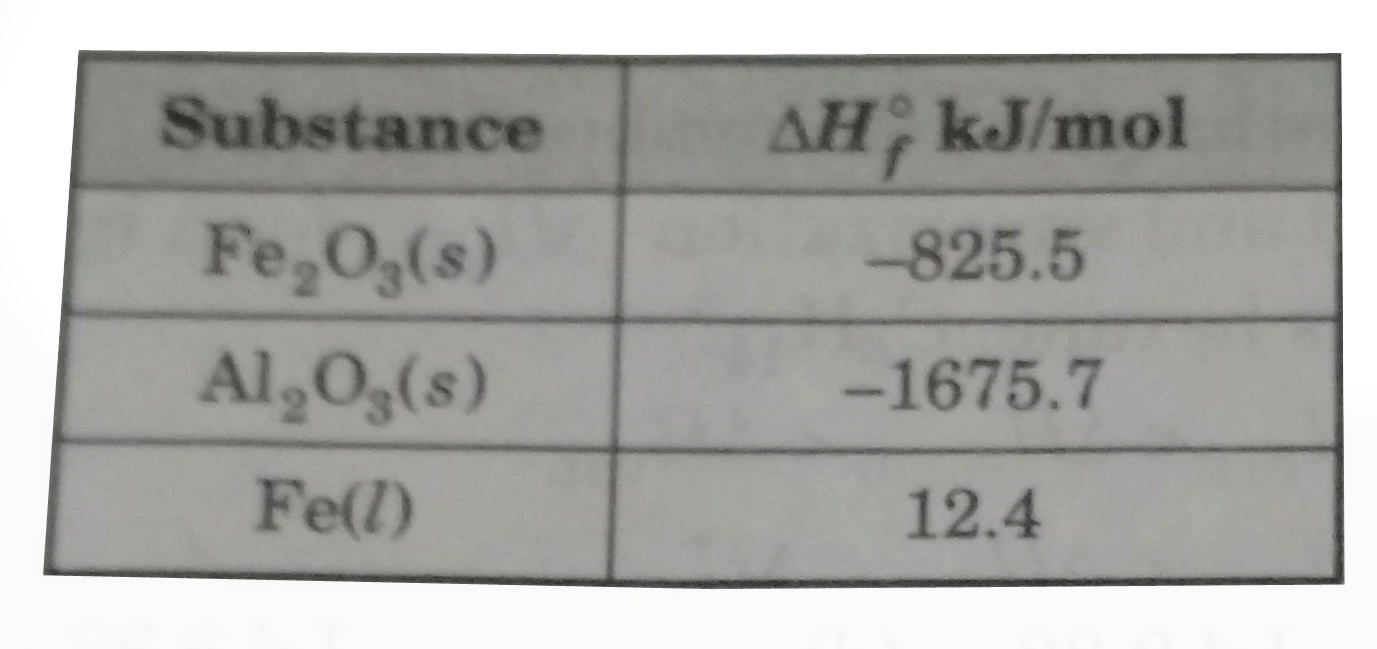If ΔG=−177Kcal for (1) 2Fe(s)+32O2(g)→Fe2O3(s) and
ΔG=−19Kcal for (2) 4Fe2O3(s)+Fe(s)→3Fe3O4(s)
What is the Gibbs free energy of formation of Fe3O4 ?Solution in Telugu
+229.6kcalmol
−242.3kcalmol
−727kcalmol
−229.6kcalmol
The correct Answer is:B
Reaction for formation of Fe3O4 is
3Fe(s)+2O2(g)→Fe3O4(s) …(1)
And we have reactions as follows: 2Fe(s)+32O2(g)→Fe2O3(s) …(2)
4Fe2O3(s)+Fe(s)→3Fe3O4 ..(3)
Eq (1) =Eq(2)×4+Eq(3)×13
So, ΔG=4(−177)+(−19)3
=−242.3 Kcal/mole
Topper's Solved these Questions
- BOOK - AAKASH SERIESCHAPTER - CHEMICAL THERMODYNAMICSEXERCISE - ADDITIONAL PRACTICE EXERCISE (PRACTICS SHEET (ADVANCED) MORE THAN ONE CORRECT ANSWER TYPE QUESTIONS)5videos
CHEMICAL THERMODYNAMICS
- BOOK - AAKASH SERIESCHAPTER - CHEMICAL THERMODYNAMICSEXERCISE - ADDITIONAL PRACTICE EXERCISE (PRACTICS SHEET (ADVANCED) LINKED COMPREHENSION TYPE QUESTIONS)5videos
CHEMICAL THERMODYNAMICS
- BOOK - AAKASH SERIESCHAPTER - CHEMICAL THERMODYNAMICSEXERCISE - ADDITIONAL PRACTICE EXERCISE (LEVEL - II LECTURE SHEET (ADVANCED) INTEGER TYPE QUESTIONS)4videos
CHEMICAL THERMODYNAMICS
- BOOK - AAKASH SERIESCHAPTER - CHEMICAL THERMODYANMICS EXERCISE - Questions For Descriptive Answers28videos
CHEMICAL THERMODYANMICS
- BOOK - AAKASH SERIESCHAPTER - ELECTRON MIGRATION EFFECTS EXERCISE - QUESTIONS FOR DESCRIPTIVE ANSWERS10videos
ELECTRON MIGRATION EFFECTS
Similar Questions
A piston cylinder device initially contains 0.2m3 neon (assume ideal ) at 200kPa inside at T1∘C. A valve is now opened and neon is allowed to escape until the volume reduces to half the initial volume. At the same time heat transfer with outside at T2∘C ensures a constant temperature inside. Select correct statement(s) for given process
 03:31View Solution
03:31View SolutionLiquid water freezes at 273K under external pressure of 1 atm. The process is at equilibrium H2O(l)⇔H2O(s) at 273 K & 1 atm. However it was required to calculate the thermodynamic parameters of the fusion process occuring at same pressure & different temperature.Using the following data, answer the question that follow. dice=0.9 gm/cc, dH2O(l) = 1 gm//c, CP[H2O(s))]=36.4JK−1mol−1
CP[H2O(l)]=75.3JK−1mol−1,ΔHfusion=6008.2Jmol−1
The value of ''ΔHfusion'' at 263K & 1 atm will be03:19View SolutionHow many of the following processes have +ve sign for entropy change?
(i) Cl2(g)⇔2Cl(g)
(ii) S8(rhombic)⇔4S2(g)
(iii) 3O2(g)⇔2O3(g)
(iv) 60C (graphite ) ⇔C60(s)
(v) Ag+(aq)+Br−(aq)⇔AgBr(s)+H2O
(vi) H2O(l)⇔H2O(s)
(vii) 2NH3(g)⇔N2(g)+3H2(g)
(viii) CuSO4(g)+5H2O(l)⇔CuSO4.5H2O(s)
(ix) Ba(OH)2.10H2O(s)+2NH40Cl(s)⇔BaCl2(s)+2NH3(g)+12H2O(l)View SolutionHow does heat of neutralisation value change with the chemical nature of acid and base?
02:51View SolutionHyperconjugation effect is also termed as 'no bond resonance'. Why?
00:53View SolutionIf ΔG=−177kcal for
(1)2Fe(s)+32O2→Fe2O3(s)
and ΔG=−19kcal for
(2)4FeO3(s)+Fe(s)→3Fe3O4(s)
What is the Gibbs free energy of formation of Fe3O4?00:58View SolutionDetermine the enthalpy change for the reaction of 5.00 g Fe2O3with aluminium metal according to the equation :
Fe2O3(s)+2Al(s)→Al2O3(s)Fe(l)
 00:53View Solution
00:53View SolutionIf ΔG=−177K cal for (1)2Fe(s)+32O2(g)→Fe2O3(s)
and ΔG=−19 K cal for (2)4Fe2O3(s)+Fe(s)→3Fe3O4(s)
What is the Gibbs free energy of formation fo Fe3O4(s)?12:13View SolutionThe enthalpy of formation of Fe2O3(s) is −824.2kJmol−1.Calculate the enthalpy change for the reaction :
4Fe(s)+3O2(g)→2Fe2O3(s)04:15View SolutionBalance the following equations.
4) Fe+O2→Fe2O304:07View SolutionBalance the following chemical equations. ii) Fe_(2)O_(3(s))+C_((s))rarr Fe_((s))+CO_(2(g))
03:49View SolutionFe_(2)O_(3(s))+2Al_((s))rarr 2Fe_((s))+Al_(2)O_(3(s)) is a/an …………….
View SolutionAl(s) and Fe(s) are oxidised by oxygen to form Al2O3(s)andFe2O3(s) respectively. If the standard enthalpy of formation of Al2O3(s)andFe2O3(s) are −1669.8 kJ mol−1and−824.2 kJ mol−1 respectively, calculate the change in enthalpy of the given reaction :
2Al(s)+Fe2O3(s)→2Fe(s)+Al2O3(s)02:59View SolutionConsider the following reactions. DeltaH^(@) values of the reactions hve been given as -x, -y and z kJ. Fe_(3)O_(4)(s) to 3Fe(s) + 2O_(2)(g), DeltaH^(@) = z kJ 2Fe(s) + O_(2)(g) to 2FeO(s), DeltaH^(@) =-x kJ 4Fe(s) + 3O_(2)(g) to 2Fe_(2)O_(3)(s), DeltaH^(@) =-y kJ Heat of reaction for the reaction, FeO(s) + Fe_(2)O_(3)(s) to Fe_(3)O_(4)(s) is :
03:13View SolutionIn the reaction , Fe_(3)O_(4)+KMnO_(4)toFe_(2)O_(3)+MnO_(2) ,the equivalent mass of Fe_(3)O_(4) is -
02:15View SolutionThe heat of formation of Fe2O3 is −824.2 kJ mol−1.ΔH for the reaction 2Fe2O3(s)→4Fe(s)+3O2(g) is :
04:23View Solution

